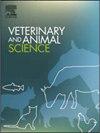荷兰动物主人报告的猫狗厌恶烟花的情况
IF 1.9
Q2 AGRICULTURE, DAIRY & ANIMAL SCIENCE
引用次数: 0
摘要
烟花(噪音)厌恶在猫和狗身上比较常见,并有可能导致动物福利受损。受影响的动物可能会表现出冷冻、躲藏、逃离等行为,也可能会出现不适当的排泄、食欲不振和(社交)退缩。在荷兰,烟花管制一直是一个备受争议的话题,我们旨在深入了解该国的主人是如何报告猫或狗对烟花的厌恶情绪的。我们收集了 3009 条狗和 622 只猫的烟花相关行为、接触情况、动物(早期生活)特征以及主人(不)同意烟花厌恶和动物指导相关声明的报告。我们的假设是:1)早期生活中的次优因素会导致更高的烟花厌恶程度;2)报告动物烟花厌恶程度较低的主人更同意 "主人的行为会影响动物未来对烟花的反应 "这一说法。我们的研究结果证实了狗的第一个假设和两种动物的第二个假设。烟花对荷兰猫、狗及其主人的影响不仅限于除夕夜,而是一年中的多个月:64%的主人从 9 月份开始就会听到烟花噪音。早期生活中的不良因素,例如幼年时没有养成噪音习惯,会导致狗对烟花的恐惧感增加,但猫不会,尤其是小猫,养成噪音习惯似乎并不常见(4% 的小猫)。狗(54%)比猫(23%)更常见烟花恐惧症。据报告,在最常使用的干预措施中,有 30% 对烟花厌恶有持久的缓解作用。这可能表明遗传和早期预防措施非常重要,但我们的受访者对反映这种重要性的说法并不十分认同。尽管我们的研究仅提供了联想证据,而且是基于主人的报告,而非直接的动物观察,但我们还是为今后的研究提出了注意点。其中一个注意点是,人们对动物早期生活因素对其一生的影响似乎认识不足。研究这种意识如何影响人们选择购买小狗或小猫的决定,以促进可能会或可能不会有烟花适应能力的动物的购买决定,最终可能会使动物受益,因为在本研究中,人们看到动物一年中有多个月会经历烟花厌恶,而治疗干预的长期效果有限。本文章由计算机程序翻译,如有差异,请以英文原文为准。
Firework aversion in cats and dogs as reported by Dutch animal owners
Firework (noise) aversion is seen in cats and dogs relatively often and comes with a risk of animal welfare impairment. Affected animals may show behaviours like freezing, hiding, fleeing, but also inappropriate elimination, loss of appetite and (social) withdrawal. In The Netherlands, firework regulation has been a much-debated topic and we aimed to provide insight into how owners in this country report on their cat's or dog's firework aversion. We gathered reports on 3,009 dogs’ and 622 cats’ firework-related behaviours, exposure, animal (early life) characteristics and owner (dis)agreement with statements relating to firework aversion and animal guidance. We hypothesized that 1) suboptimal early life factors come with higher prevalence of firework aversion and 2) owners that report less firework aversion for their animal, agree more to the statement that owner behaviour affects an animal's future reactions to firework. Our findings confirm the first hypothesis for dogs and the second hypothesis for both species. Firework affects Dutch cats, dogs and their owners not just on New Year's Eve, but for multiple months a year: 64 % of the owners heard firework noise from September onwards. Suboptimal early life factors, of for instance not being noise habituated as a young animal came with higher prevalence of firework fear for dogs, but not cats and habituating particularly kittens seemed uncommon (4 % of kittens). Advice seeking was more common for dogs (54 %) than cats (23 %) with firework aversion. For both species reporting of lasting effects of therapeutic interventions was uncommon. <30 % of the most often applied interventions were reported to have a lasting mitigating effect on firework aversion. This may indicate a high importance of hereditary and early life preventive measures, but our respondents were not in high agreement with statements reflecting such importance. Although our study presents associative evidence only and was based on owner report, not on direct animal observations, we present attention points for future studies. One such attention point is a seemingly low awareness of the lifelong influence of an animal's early life factors. Studying how such awareness affects people that opt for a puppy or kitten as to facilitate acquisition decisions that may or may not come with firework resilient animals, may ultimately benefit animals that were in this study seen to experience firework aversion for multiple months a year, with limited long-term effectiveness of therapeutic interventions.
求助全文
通过发布文献求助,成功后即可免费获取论文全文。
去求助
来源期刊

Veterinary and Animal Science
Veterinary-Veterinary (all)
CiteScore
3.50
自引率
0.00%
发文量
43
审稿时长
47 days
 求助内容:
求助内容: 应助结果提醒方式:
应助结果提醒方式:


